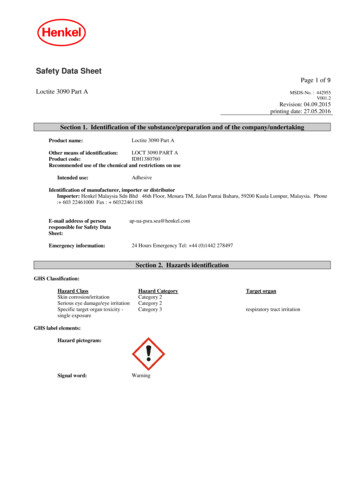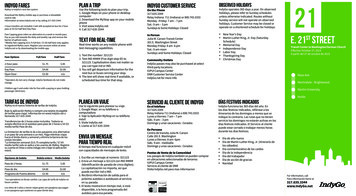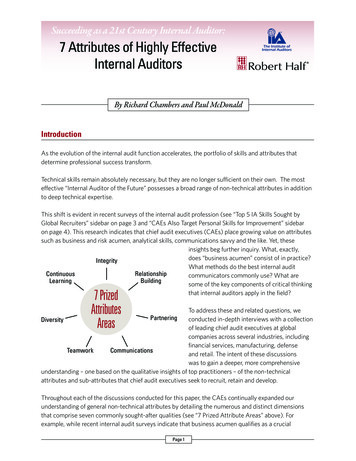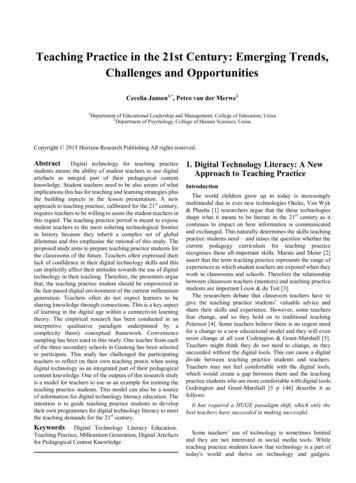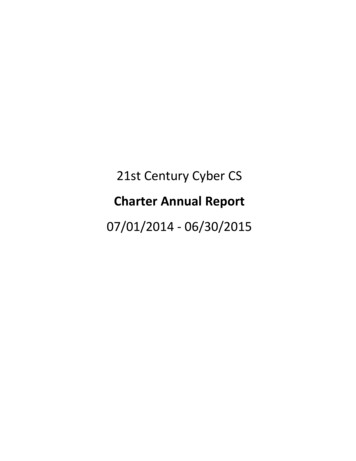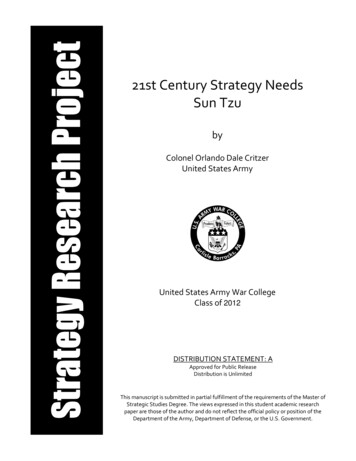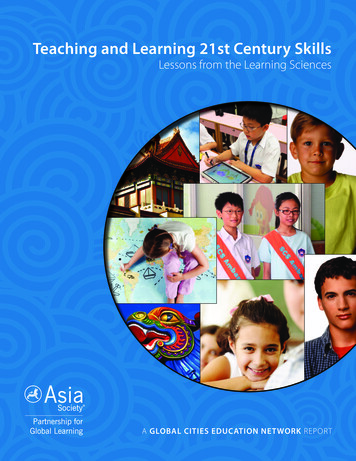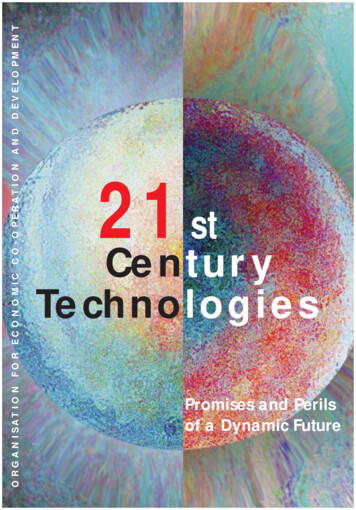
Transcription
O R G A N I S AT I O N F O R E C O N O M I C C O - O P E R AT I O N A N D D E V E L O P M E N T21stCenturyTechnologiesPromises and Perilsof a Dynamic Future
21st CENTURYTECHNOLOGIESPROMISES AND PERILSOF A DYNAMIC FUTUREORGANISATION FOR ECONOMIC CO-OPERATION AND DEVELOPMENT
ORGANISATION FOR ECONOMIC CO-OPERATIONAND DEVELOPMENTPursuant to Article 1 of the Convention signed in Paris on 14th December 1960,and which came into force on 30th September 1961, the Organisation for EconomicCo-operation and Development (OECD) shall promote policies designed:– to achieve the highest sustainable economic growth and employment and a risingstandard of living in Member countries, while maintaining financial stability, andthus to contribute to the development of the world economy;– to contribute to sound economic expansion in Member as well as non-membercountries in the process of economic development; and– to contribute to the expansion of world trade on a multilateral, non-discriminatorybasis in accordance with international obligations.The original Member countries of the OECD are Austria, Belgium, Canada,Denmark, France, Germany, Greece, Iceland, Ireland, Italy, Luxembourg, theNetherlands, Norway, Portugal, Spain, Sweden, Switzerland, Turkey, theUnited Kingdom and the United States. The following countries became Memberssubsequently through accession at the dates indicated hereafter: Japan (28th April 1964),Finland (28th January 1969), Australia (7th June 1971), New Zealand (29th May 1973),Mexico (18th May 1994), the Czech Republic (21st December 1995), Hungary(7th May 1996), Poland (22nd November 1996) and Korea (12th December 1996). TheCommission of the European Communities takes part in the work of the OECD(Article 13 of the OECD Convention).Publié en français sous le titre :LES TECHNOLOGIES DU XXIe SIÈCLE :PROMESSES ET PÉRILS D’UN FUTUR DYNAMIQUE OECD 1998Permission to reproduce a portion of this work for non-commercial purposes or classroom useshould be obtained through the Centre français d’exploitation du droit de copie (CFC),20, rue des Grands-Augustins, 75006 Paris, France, Tel. (33-1) 44 07 47 70,Fax (33-1) 46 34 67 19, for every country except the United States. In the United Statespermission should be obtained through the Copyright Clearance Center, Customer Service,(508)750-8400, 222 Rosewood Drive, Danvers, MA 01923 USA, or CCC Online:http://www.copyright.com/. All other applications for permission to reproduce or translate all orpart of this book should be made to OECD Publications, 2, rue Andr é-Pascal,75775 Paris Cedex 16, France.
FOREWORDAs part of the preparations for EXPO 2000 – the World Exposition inHannover, Germany – the OECD Forum for the Future is organising a series of fourconferences to take place beforehand around the theme of ‘‘People, Nature andTechnology: Sustainable Societies in the 21st Century’’. The series will considerfour key areas of human activity: technology, economy, society and government.The conferences will explore possible evolutions of key variables and analysedifferent development paths in order to expose some of the main policy implications and options. Each conference will provide analysis of underlying trends andpolicy directions. However, the overall aim of the series is to build a comprehensive foundation for assessing the critical choices likely to face citizens and decision-makers in the next century.The entire series is benefiting from special sponsorship by EXPO 2000and four German banks – Bankgesellschaft Berlin, DG BANK DeutscheGenossenschaftsbank, NORD/LB Norddeutsche Landesbank, and WestdeutscheLandesbank Girozentrale (WestLB). Additional financial support is provided bynumerous Asian, European and North American partners of the OECD Forum forthe Future.The first of these conferences, hosted by the Westdeutsche Landesbank(WestLB), was held at Schloss Krickenbeck near Düsseldorf, Germany 7-8 December 1997. The theme was ‘‘21st Century Technologies: Balancing Economic, Socialand Environmental Goals’’.Shaping the future in order to realise economic and social goals is one of thefundamental challenges of human society. Technology has proved key in meetingthis challenge, and its role appears set to remain at least as important in thefuture. However, there are many uncertainties with regard to the transformation oftechnological potential into positive economic and social outcomes. Indeed, formany people displaced at work or bewildered by new, unfamiliar products, itseems as if technological progress is more of a curse than a blessing. This firstconference examined both the positive and the negative sides, the opportunitiesand the risks, that may arise as technology develops over the next twenty-five3
21st CENTURY TECHNOLOGIESyears. In so doing, it explored the two-way relationship between technology onthe one hand and economy and society on the other.The conference was organised into three sessions. The first assessed generaltrends in pervasive technologies, particularly information and biological technologies, with the aim of identifying areas of technically feasible future applications.The second session explored how different economic, social and politicalframeworks might lead to differences in the extent to which technological opportunities are realised and risks reduced. In the concluding session, the focus wason the policy directions most likely to enhance the contribution of technology tothe realisation of sustainable economic, social and environmental goals.This publication brings together the papers presented at the meeting as wellas an introductory contribution and summary of the main points of the discussionsprepared by the Secretariat. The book is published on the responsibility of theSecretary-General of the OECD.4
TABLE OF CONTENTSChapter 1.Chapter 2.Chapter 3.Chapter 4.Chapter 5.Chapter 6.The Promises and Perils of 21st Century Technology: An Overview ofthe Issuesby Riel Miller, Wolfgang Michalski and Barrie Stevens . . . . . . . . . . . . . . . . . . .7The Next Twenty-five Years of Technology: Opportunities and Risksby Joseph Coates . . . . . . . . . . . . . . . . . . . . . . . . . . . . . . . . . . . . . . . . . . . .33Faster, Connected, Smarterby Hervé Gallaire . . . . . . . . . . . . . . . . . . . . . . . . . . . . . . . . . . . . . . . . . . .47Biotechnology for the 21st Centuryby Werner Arber and Mathis Brauchbar . . . . . . . . . . . . . . . . . . . . . . . . . . . .77Technological Development and Organisational Change:Differing Patterns of Innovationby Meinolf Dierkes, Jeanette Hofmann and Lutz Marz . . . . . . . . . . . . . . . . . . .97Enabling Macro Conditions for Realising Technology’s Potentialby Emilio Fontela . . . . . . . . . . . . . . . . . . . . . . . . . . . . . . . . . . . . . . . . . . . 123Chapter 7. Global Possibilities: Technology and Planet-wide Challengesby Luc Soete . . . . . . . . . . . . . . . . . . . . . . . . . . . . . . . . . . . . . . . . . . . . . .147Annex: List of Participants . . . . . . . . . . . . . . . . . . . . . . . . . . . . . . . . . . . . . . . . . . . . . 1715
1THE PROMISES AND PERILSOF 21st CENTURY TECHNOLOGY:AN OVERVIEW OF THE ISSUESbyRiel Miller, Wolfgang Michalski and Barrie StevensOECD Secretariat, Advisory Unit to the Secretary-GeneralOver the past century there have been many profound technological, economic and social transformations. In OECD countries the full development anddiffusion of innovations such as electricity, telephones and automobiles haveaccompanied the emergence of mass production, mass consumption and massgovernment. There are many who, facing the next century, wonder if it will bepossible and/or desirable to continue along the path of such prodigious change.Some worry about the capacity, both technological and social, to continue advancing and inventing new tools, new products and new ways of organising everydaywork and home life. Others worry that the ongoing transition costs may be toohigh, or that the risks to cherished traditions or the threats to environmentalsustainability will, singly or together, be too great to bear. Preservation versusdynamism, incrementalism versus radicalism, these are the polar extremes that,unsurprisingly, haunt many end-of-the-century, future-of-the-millennium debates.The OECD Forum for the Future Conference on 21st Century Technologieswas no exception; all of these perspectives were analysed and discussed. However, perhaps the most striking thing about the conference was the widely heldview that the prospects for prosperity – economic, social and environmental –over the next twenty-five years will probably hinge on actively encouragingchanges equal to, if not greater than, those already experienced in the twentiethcentury. In particular, realising the full potential of tomorrow’s technologies tocontribute to human well-being was seen as depending heavily on the capacity toembrace dynamic change. With only a few reservations, the analysis affirmed thebenefits of pursuing socio-technical dynamism rather than preservationism. Theanalysis also underscored the urgency of pushing beyond incremental and ad hoc7
21st CENTURY TECHNOLOGIESreactive approaches in order to develop and implement more transformative andintegrated economic, social and technological courses of action.This introductory chapter is divided into three sections. The first focuses onthe prospects for twenty-first century technologies – largely ignoring economic orsocial factors – given the current state of play in today’s research and development labs. The second considers the crucial economic and social forces – at micro,macro and global levels – that are likely to play key roles in determining both thepath of technological development and its diffusion. Lastly, the chapter offers anassessment of policy initiatives that might foster the most beneficial patterns oftechnological development and distribution.I.ENVISIONING TECHNOLOGY’S POTENTIAL: OPPORTUNITIESAND RISKSImagining possible applications of technology two or three decades from nowcalls for a better understanding of the ways in which performance trends interactwith societies’ readiness to embrace economic, social and technical change. Inventuring a vision of technological possibilities rather than simply projectinglinear or exponential changes in performance, it is crucial to think not only of howtechnical improvements lead to the substitution of a new generation of tools forexisting ones, but also of how entirely new uses, and indeed new needs, mightemerge.Significant progress is likely across a broad spectrum of technologies, discussed in Joseph Coates’ contribution to this volume: computing, genetics, braintechnology, new materials (in particular miniaturisation and smart composites),energy, transportation and environmental tools and systems. The technical foundation (as distinct from the economic and social) for this continuing wave ofinnovation will emerge, in large part, from powerful developments in the fields ofdigital and genetic information. The exploration and manipulation of these twobuilding blocks – one of calculation, the other of nature – are likely to unlock vasttreasures for both tool-builders and -users. Indeed, there seems to be a strongvirtuous circle between better information and higher performance tools, as eachinsight provided by digital computation or genetic mapping (still at an earlystage) helps to drive forward new ideas about how to design and use technology.8This complementarity is particularly powerful in the digital realm. Improvements in the quantity and quality of the information transformed into strings ofzeros and ones are allowing rapid advances to be made in many other domains ofscience and engineering.
THE PROMISES AND PERILS OF 21st CENTURY TECHNOLOGYAdvances in the performance and use of digital informationPerformanceOne way of tracking technological change over time (and into the future) is toconsider measurements of speed, size or cost. From this perspective, progress iseasy to calibrate. Twenty-five years ago a megabyte of semiconductor memorycost around 550 000; today it costs around 4. Microprocessors in 1997 were100 000 times faster than the 1950 originals. Should these trends continue – andthere are many experts who think they will – by 2020 one desktop computer willbe as powerful as all of the computers currently in Silicon Valley.Faster, cheaper, smaller are more than slogans for the highly competitive information technology sector, as will become clear in the chapter byHervé Gallaire. In the development pipeline are a number of improvements thatmight even accelerate the already rapid pace of cost/performance improvement.For example, there is a good chance that mixed optical/silicon computers willcome into widespread use. This will allow laser beams to transmit data within acomputer chip, thereby overcoming some of the bottlenecks – such as excessiveheat – that arise from miniaturisation of circuits on semiconductors. Developments in low-temperature superconducting and new refrigeration methods willalso allow improvements in processing power. Quantum mechanical computingappears to be on the horizon, promising potentially large gains in computationspeeds. All told, the prospects for the key component of computing technology– the microprocessor – look very promising.Network technology as well will continue to move forward along a path thatdelivers both greater diversity and much higher bandwidth. Heavy-duty transmission systems will lean on ever-faster fibre optical systems, while mobile communications coverage will rain down from a variety of low- and high-orbit satellites. Alarger part of the available frequency spectrum will be better used by digitalbroadcasts and compression methods that allow high-density data flows to reacha wide variety of locations and devices. Home installation of a personal network(PN) will become affordable. For users, communication services may not quitereach zero cost, but they will be close to it by the third decade of the nextcentury.Considerable progress will likely be made in improving the human-computerinterface, largely because voice and gesture recognition will have been perfected.Instantaneous real-time translation may also be quite close to fully functionalby 2025. All audio, video and text-based data sources will be in digital formand amenable to universal searches. Most current computer-related security,privacy and inter-operability questions will have been resolved, allowing forthe same degree of confidence (sometimes more, via instant verification) thatcurrently obtains when it comes to face-to-face transactions and communication.9
21st CENTURY TECHNOLOGIESSemiconductor-based sensors, some at the molecular or atomic level and integrated with DNA, will be able inexpensively to collect vast quantities of highlyprecise environmental and biological information, and begin to open up newfrontiers for direct human-machine interconnection.One potential brake on performance improvements in the field of IT could besoftware. Many analysts see only modest advances in the area of ‘‘artificial intelligence’’ over the next two decades. The quest for software that is fully capable ofundertaking autonomous thought and able to respond with inference and creativity to human conversation will probably continue well into the middle of the nextcentury. However, intelligent agents capable of accumulating data about anindividual’s tastes and behavioural patterns are likely to emerge over this period.Considerable progress is also expected in the development of VRML (VirtualReality markup language), a three-dimensional version of the text-based HTML(hypertext markup language) that currently dominates Web pages on the Internet.UsesTwenty-five years from now, after more than five decades of development,the microprocessor, information technologies in general, and networks will probably have penetrated every aspect of human activity. Many parts of the world willbe wired, responsive and interactive. Beyond simply accelerating the pace ofchange or reducing the cost of many current activities, the use of these highperformance digital tools opens up the possibility of profound transformations.There is a good chance that the advanced power of computing will be used tohelp people stay in or create new kinds of communities, both virtual and real. Insome parts of the world this could mean a return to villages and less urbansettings. In other regions, perhaps where there is better infrastructure or otherattractions, people will stick to their ‘‘silicon alley’’. In either case, the use ofcomputing power will allow us to make choices about where and how we live andwork that were not possible before. The trade-offs imposed by distance willchange in the networked world of 2025. Physical isolation no longer needs toimpose as great an economic or social penalty.10The use of computing power will greatly enhance possibilities in production,transportation, energy, commerce, education and health. For instance, industrialrobots will most likely become ubiquitous as the better software and hardwareallow them to take on onerous, dangerous, high-precision or miniaturised tasks inmany sectors of the economy. They will also be employed in deep sea and outerspace operations. Computers will probably influence the environmental costs oftransportation by both improving vehicle design/engineering (hybrid cars, hydrogen fuel-cell engines, etc.) and traffic management. In the field of energy production and conservation, whole new horizons will open up as computers and net-
THE PROMISES AND PERILS OF 21st CENTURY TECHNOLOGYworks reduce the costs and risks of co-generation and allow the proliferation oflocal management of energy production and use. Powerful computers will make iteasier to design products that are more environmentally sustainable because theproduction process is less wasteful and the end-product can be recycled, reusedor remanufactured.At a broader level, computer-enabled development of electronic commerceis likely to profoundly modify current ways of doing business. Anyone with acomputer and Internet access will be in a position to become a merchant andreach out to customers across the globe, and any consumer will be able to shopthe world for goods and services. As a result, new products and services and newmarkets should emerge, many a traditional role of intermediary could disappear,and more direct relations will probably be forged between businesses andconsumers. Indeed, the process of inventing and selling products could be turnedon its head, as consumers generate the custom specifications they desire andthen seek out competent producers and even other buyers.As for the inquiry and collaboration that are indispensable for learning andbasic scientific research, the power of tomorrow’s Information Technologies willopen up new vistas by radically improving the capacity to communicate andsimulate. Virtual Reality’s capacity to mimic historical and physical situationsmight mean that learning by ‘‘doing’’, joint experimental research and moving atone’s own pace are all within every ‘‘wired’’ person’s grasp. Once liberated fromsome of the cost, time and space constraints of traditional education, it mighteven be possible to get beyond the socialisation methods of industrial eraschooling to create a system that encourages individual creativity.In order to avoid drowning in an ocean of information, people will probablyuse ‘‘knowbots’’ (knowledge robots) to navigate effectively. Virtual robots withfairly narrowly defined tasks, a type of expert software, will have reached thepoint of being able to track and respond to many human needs, from the banalcapacity of a networked toaster to identify users and recall their preferences tothe more advanced functionality of e-mail screening, comparison shopping andassembling/tracking a person’s customised learning ‘‘adventures.’’ And in the fieldof healthcare, self-contained portable sensing and diagnostic equipment linkedup to remote expert systems could bring about significant improvements inpatient mobility and hospital resource efficiency.Advances in the performance and use of genetic informationPerformanceThe identification of genetic information and applications of genetic engineering are already making their mark in many of areas of human activity. Whilethey are unlikely to have quite the same pervasive impact as Information11
21st CENTURY TECHNOLOGIESTechnology on the organisational aspects of economy and society, they will nonetheless profoundly affect many facets of everyday life. Those that stand out mostfrom today’s perspective are human health, food production (livestock, plants)and food processing, and activities at the crossroads between genetics and othertechnologies.Work is already well under way on the human genome, a subject taken up inthe chapter by Werner Arber and Mathis Brauchbar. By 2005, after fifteen years ofintense activity, scientists should know the full DNA sequence of a typical man orwoman. Although at present only a very small percentage of this information hasbeen mapped, the pace of discovery is expected to accelerate dramatically. Asthe average cost of sequencing each of the millions of DNA base pairs rapidlydiminishes – from 5 in 1990 to less than fifty cents by the beginning of the nextcentury – the number of DNA base pairs sequenced each year is rising exponentially: from around 40 million in 1990 to over 400 million in 1997. In parallel, thenext twenty-five years could see major breakthroughs in disentangling the complexity of the human body’s biochemical pathways along which genetic information is transferred, and in understanding how certain genes interact with environmental influences to exert different effects on different people.What the next twenty-five years are likely to witness is the identification andmapping of the genomes of thousands of prototypical creatures – mammals, fish,insects, micro-organisms and plants. Large-scale initiatives are currently close toimplementation. In the United States, for example, the National Science Foundation has launched a major 40 million Plant Genome Initiative, and the Department of Agriculture is working towards a 200 million National Food GenomeStrategy. As the biochemical pathways of gene transfer are worked out for animaland plant life forms, vast possibilities could open up for the refined management,control and manipulation of their health, propagation or elimination. Routinegenetic programmes could emerge for enhancing animals and plants, leading tofaster breeding cycles, accelerated plant evolution, and the development ofincreasing numbers of patentable varieties. Twenty years from now, virtuallyevery widely distributed seed could have been influenced in one way or another(i.e. through cross-fertilization or genetic manipulation) by genetic engineering.12But perhaps the most dramatic breakthroughs in the not-too-distant futurewill be achieved through combinations of various scientific disciplines. For example, work cutting across biochemistry, physics, molecular biology, neurosciences,biotechnology, nanotechnology and microelectronics looks set to make significantadvances in the field of bioelectronics (e.g. the development of biosensors) andneuroinformatics (linking microprocessing with the human nervous system). Withthe expected trend toward greater diversification of R&D spending on geneticsinto chemicals, materials, energy technologies, etc., major advances in othercross-disciplinary fields could take on significant proportions – e.g. the creation of
THE PROMISES AND PERILS OF 21st CENTURY TECHNOLOGYsynthesised gene-derived enzyme catalysts, non-existent in nature, for use inchemical engineering; biological processes to fabricate molecular structures andmore complex materials; bioengineered plants to produce pharmaceuticals andraw materials for plastics.UsesBiotechnology applications are likely to pervade most areas of activity in thenext quarter-century. Already well entrenched and expanding in human health,animal husbandry, plant agriculture and food processing, they could find theirway increasingly into environmental management, manufacturing processes, newmaterials and computers.It is in human health that most people expect the greatest progress over thenext decades. With the mapping of the human genome and the identification ofbiochemical transmission routes and of genetic predispositions, genetic testingcould become routine. Therapies for single-gene and even some multiple-genedisorders could be widespread by 2025, as could gene replacement therapy. Theprescription of gene-based pharmaceuticals might by then be commonplace – forexample, those using antisense DNA to block the body’s process of transmittinggenetic instructions to trigger a disease process. Concretely, disorders transmitted by a single gene, such as Huntington’s Chorea and cystic fibrosis as well ascertain types of Alzheimer’s disease, arthritis and cancer, could by 2025 be bothtreatable and possibly reversible. Thanks to advances in interdisciplinaryresearch, life expectancy and physical mobility could be further enhanced: withthe increasingly standard application of biosensors in diagnosis; and, in surgery,the use of sensor implants, neuronal prostheses (e.g. for simulating hearing orrestoring the functions of paralysed limbs) and even organ cloning.The impact on the delivery of healthcare promises to be fundamental. It isnot simply a matter of treatments becoming much more individualised. Thequantum leap in genetic knowledge, information, diagnosis, prevention and therapy, combined with continuing progress in other technologies (notably IT) wouldmean – at least in the more advanced societies – more personal control overhealth and more possibilities for self-treatment, and thus more lifestyle choices.As a result, healthcare delivery could become much more decentralised. Indeed,the practice of medicine, increasingly encroached upon by research, self-diagnosis and self-treatment, may gradually be obliged to take a back seat.With numerous prototypical animals, plants, insects and micro-organismsmapped and their gene delivery systems worked out, major avenues would openup for applications in food and agriculture. Genetically modified plants areincreasingly common – in 1997 American farmers planted some 10 million hectares with genetically engineered seeds, and across the world some two dozen13
21st CENTURY TECHNOLOGIESvarieties of genetically modified plants are in use. It is not difficult to conceive ofroutine production of transgenic customised livestock, fruit and vegetables, forming the basis for widespread consumption of ‘‘designer’’ food and new varietiesand products. Transgenic sheep, pigs and cows may be kept as living factories toproduce proteins and other much sought-after compounds, for example in theirmilk, or may be modified to resist particularly harsh climates. Aquaculture wouldhave at its disposal genetic engineering techniques to refine the different tastesand textures of seafood. Crop plants and forest stocks across the world could bemodified for inbuilt pest resistance, insecticidal or chemical properties, betterstorage, and greater adaptation to specific environmental conditions.The outcome would be the prospect of significantly improved diets andgreatly expanded food choices for consumers. For producers, it would meannothing less than a radical transformation of farming practices and structures.Farmers will face a wide range of options as to new varieties, new products, andthe degree of animal or crop specialisation they would need to pursue. New typesof producer could enter the arena (e.g. pharmaceutical companies rearing transgenic animals for specific substances), and relations between producers, processors, retailers and consumers would likely be transformed by the emergence ofhighly specified, highly customised ordering systems.Risks associated with advances in new technologiesStill, with all this scientific promise, there are myriad risks that could beprovoked or exacerbated by tomorrow’s plausible technological innovations. Ashas been the case ever since technologies were employed not only for survivalbut also for conflict, these tools often have a double edge. Technologicaladvances per se provide no foregone conclusions about how they will be used.Indeed, looked at purely from the perspective of technical feasibility – withouttaking into account the economic and social safeguards that are likely to beprerequisites for the rapid emergence of tomorrow’s technological breakthroughs – three broad dangers can be identified.14First, tomorrow’s technologies contain destructive potential that will be bothpowerful and difficult to control. They could pose threats to the natural andhuman environment. Either by accident or through malevolence, the advancesand diffusion of genetic engineering could give rise to unintended, unanticipateddiseases, ecological vulnerabilities, and weapons of mass destruction. Dependence on computers, networks and the software that runs them could leavecritical parts of society’s life-support systems, from nuclear power plants andmedical systems to security and sewage treatment facilities, open to both inadvertent yet catastrophic crashes and intentionally debilitating attacks. Lessdeadly but still pernicious risks might emerge as the spread of information tech-
THE PROMISES AND PERILS OF 21st CENTURY TECHNOLOGYnology makes it easier to violate basic privacy or civil rights and to engage incriminal practices ranging from fraud and theft to illegal collusion.A second set of purely technological risks involves the possibility of greatervulnerability to system-wide breakdowns in, for example, the air-traffic controlinfrastructure. Some people fear that as the world becomes mo
part of this book should be made to OECD Publications, 2, rue Andr e-Pascal, 75775 Paris Cedex 16, France. . as an introductory contribution and summary of the main points of the discussions prepared by the Secretariat. The book is published on the responsibility

